Greetings from Casa Alitas #2
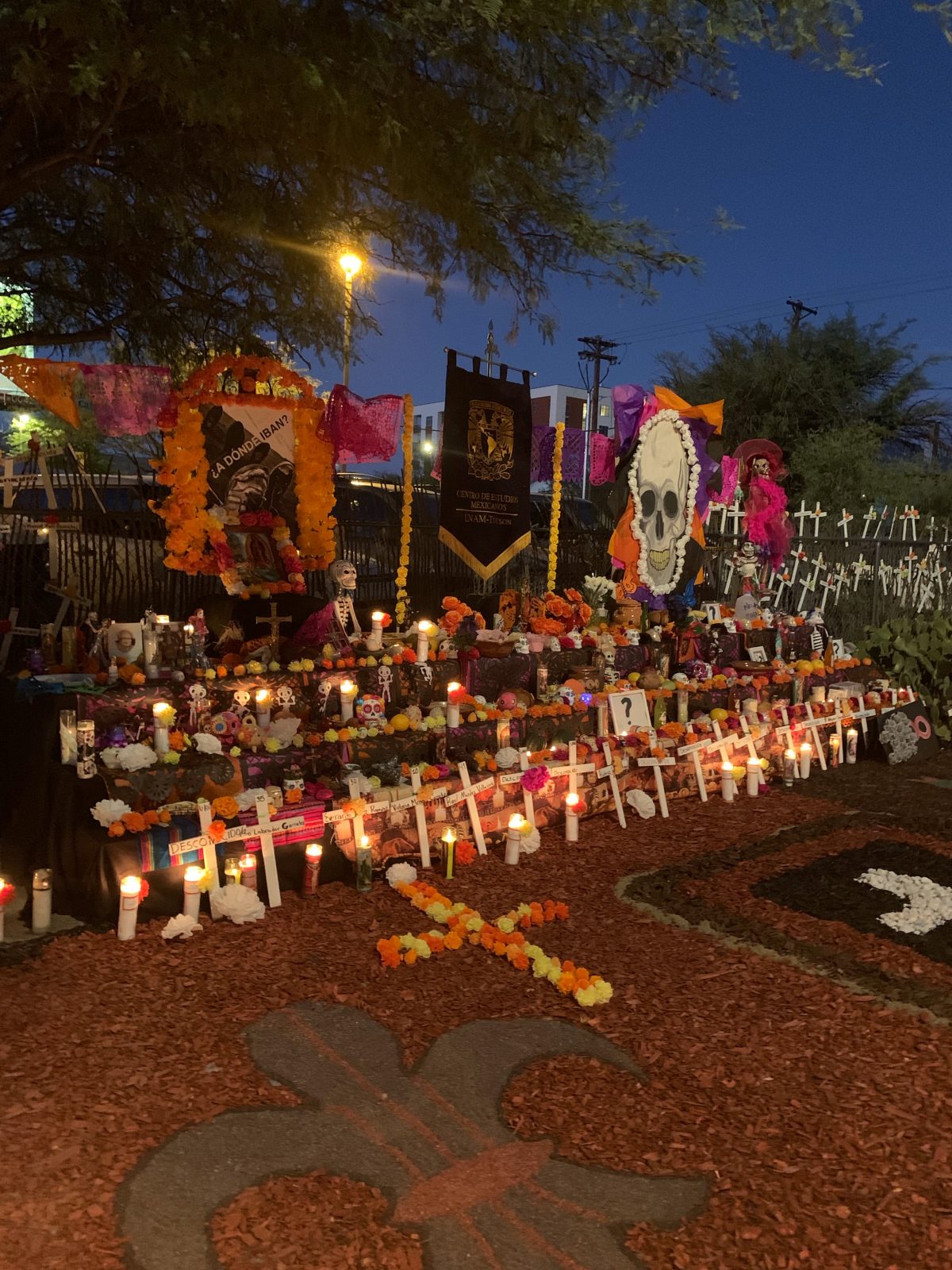
Hello Friends,
I so much appreciated the Sunday morning sermon on thin places. I was particularly aware of this presence with God at the top of Mt. Lemmon outside Tucson on Saturday. I was invited to join a friend, Marian (Jill Westberg’s first cousin) for a drive up the mountain, all 10,000 feet, and observe the changes in scenery as we ascended, first desert, then pines, then golden aspen. As in Wisconsin, the leaves were wild with beauty. We had many quiet moments, standing in awe of our surroundings. I think this awe was shared by others we saw at pull-off points. Conversations were muted, people walked slowly, and the bright blue sky and standing-rock formations seemed to almost talk to us, reminding us both of our minuscule spot in the history of time while also our uniqueness and ability to change the world.
The experience of Mt. Lemmon was a perfect entree to All Soul’s Day / Week in Tucson. There is celebration of Halloween particularly with the kids. But in Tucson, this week is less secular than in many cities. As in the Mexican tradition, it is the week to remember relatives who have died in previous years by visiting their graves and, with ease, having conversations with their loved ones, alive or dead. Indeed, it is recognition of the thin veil that separates the living from the dead, the celebration of El Día de los Muertos.
There are El Día de los Muertos processions in Tucson every night of this week, with a very large (thousands) and long (several miles) one this Sunday November 7, ending in a well-known market area in downtown Tucson. I chose to participant in a smaller procession sponsored by the local Immigration Justice Center and taking place in South Tucson, traditional home of the Latin community. The procession ended at what is referred to as the Tiradito, a small park area about the size of Friendship Hall that is designed as a meditative remembrance spot for the community. There is a small altar at one end of the area. I had visited this spot the last time I was here and at that time the small altar was filled with small remembrances and crosses from previous visitors.
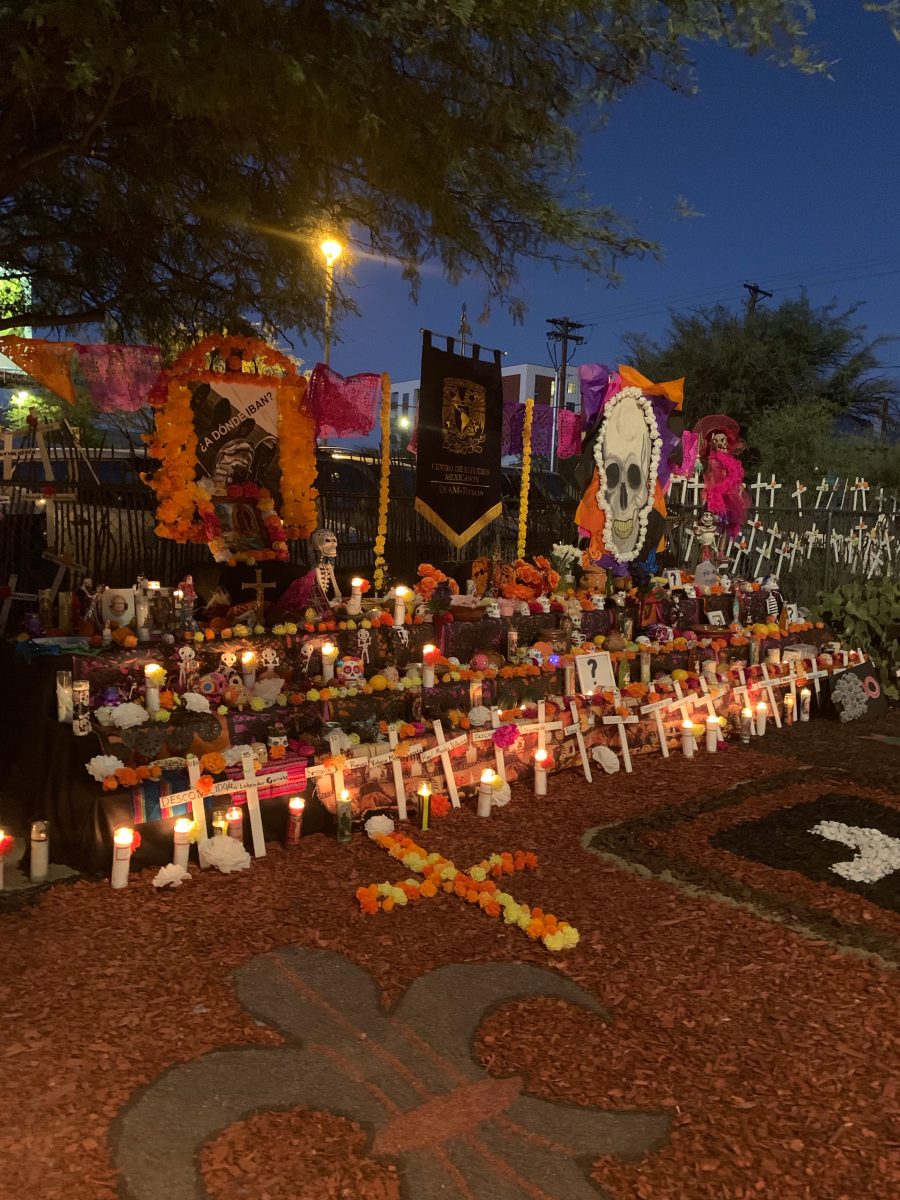
For last night, people has constructed a much larger altar, filled with candles and crosses. I’ll include a photo. The crosses had the names of the people who had died in 2021 written on them. However, instead of names, the majority of the crosses had the word “Desconocido” written on them, meaning “unknown.” These were people whose remains had been found in the desert. The primary focus of the evening was the reading of the names of the people on the crosses. After each name, we were asked to respond, “Presente,” affirming the presence of the spirit of those people among us. The list included the names of 197 people. It reminded me of our worship service when we are asked to stand and name a person we want to remember as in a litany. And, of course, there was music, great music, initially slow and mournful, then ending, would you believe, in “la bamba.” It was a wonderful evening in many ways.
And I don’t remember mentioning in my first email that I attended worship at Southside Presbyterian Church.Southside is best known for its history as a sanctuary church.It’s a small church in a circular formation.There is a person at the door who takes your temperature.The worship itself is available on line, and the Sunday I attended was the first Sunday that the church was open to congregants. One of the moments I especially appreciated was the initial prayer of blessing in the Tohono O’Odham language. This Sunday was also the day that the church officially renamed the principal rooms of the church in the Tohono O’Odham language.The minister, Rev. Alison Harrington, had us repeat each of the new names with her three times.Also, what an interesting choice of names – Rain, Sun, Butterfly, Saguaro, The Wind Before the Rain – all in Tohono O’Odham.It made me wonder what the names of our rooms would be like in Ho Chunk.And I can’t not say something about the music.Ah, yes, the music, a choir of 7 people who sounded like they had all sung in gospel choirs.It was chilling – and everybody sang out, loud and clear.
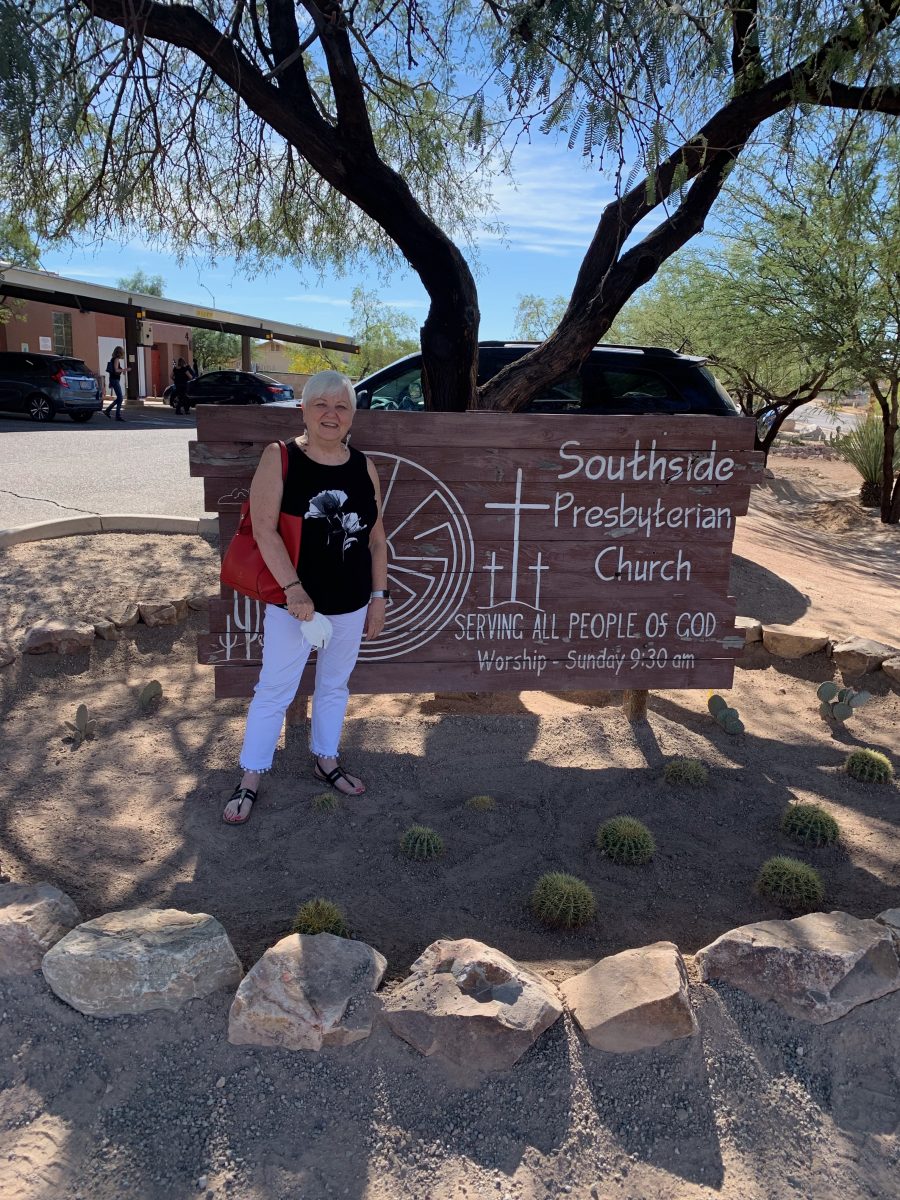
Now turning to Casa Alitas – I head over daily about noon. People are dropped off by ICE about 2pm. The men arrive in chains and shackles that the Border Patrol officers remove after they step out of the Border Patrol van. Families also arrive in vans, no chains. The word that comes to me to describe the families is despirited. Then everyone passes through a chain of quiet “bienvenidos” from the volunteers, given a KN95 mask, and asked to be seated in the open patio area. First thing is the COVID-test, given to all. On average, only one in 100 has COVID – I find this amazing. Those who test positive are immediately asked to sit elsewhere and are shuttled off to a separate hotel where they will be quarantined. More waiting for them. None of the people I have seen who tested positive are feeling ill. Nevertheless, needless to say, their results prompt more tests and quarantine for them.
After a brief introduction to Casa Alitas by one of the site leads, the next step is what we refer to as “intake.”This is my baby.I love doing intake.It is basically an interview in which we gather the information we need to arrange transport to sponsors, set in motion searches for family members from whom people were separated at the border, and other similar details. I do this slowly, basically trauma-training 101. I see no need to rush so thy can wait some more for the next step. I welcome them, ask about their health, find out about their families, and talk with them a bit about the city or state where they’ll be headed.We then serve hot chicken soup and a sandwich – most have had nothing but cold burritos for 5 days.And from there I escort them to the “tienda de ropa,” a large, separate room with lines of donated clothing and shoes.Their eyes pop.I think if I weren’t there, they’d be stripping of their old clothes with abandon. Instead, they hurry into small cubicles to change.It’s almost a ceremonial act when they find something that fits and they toss their old clothes in a huge trash can.No doubt that the clothes area is one of the happier moments of their short stay.From that point, it’s all on deck to help each one of them with travel arrangements.Most will fly out the next day, and will be transported late afternoon to the central Tucson Hyatt Hotel.The hotel houses only guests from Casa Alitas, and each guest gets their own room.They are thrilled to find out they will have their own room, shower, and bed.I’ve left out many details here, but you can imagine all that’s happening when 60 men arrive at the same time.Intense but also filled with many warm fuzzies.
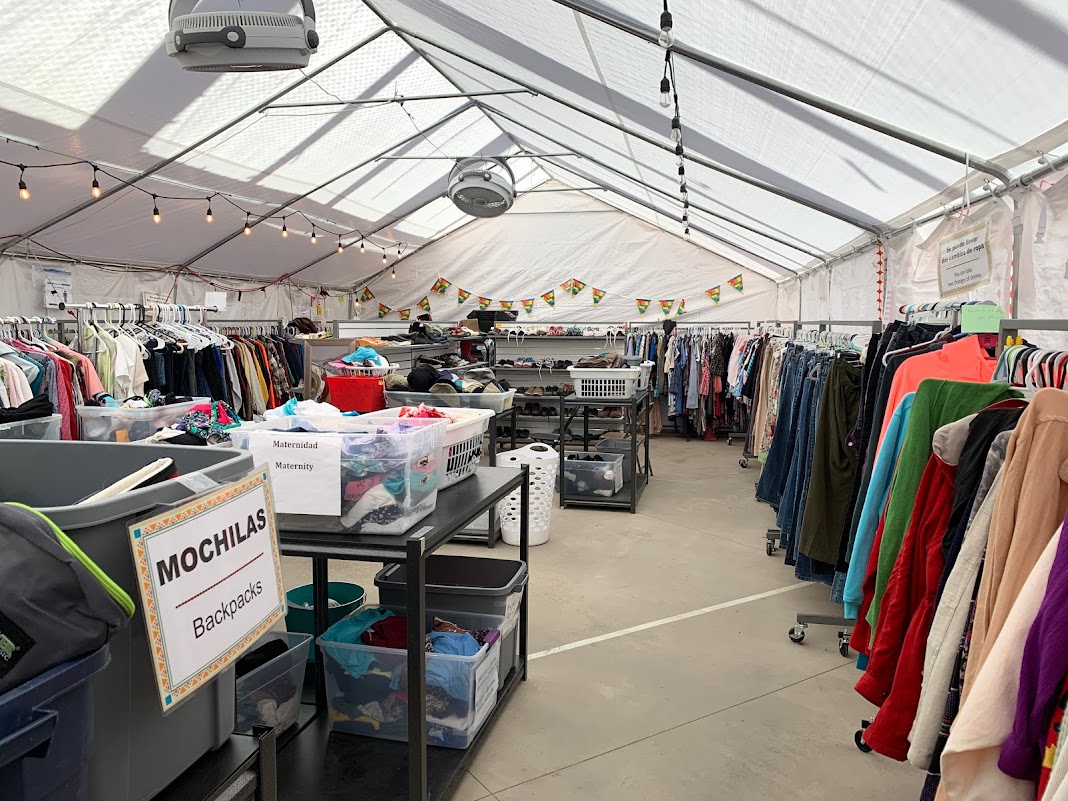
Per above, the majority of people arriving now are men from Cuba or Venezuela. Many have saved for years to fly, for example, from Cuba to Ecuador, then to Chile and/or Mexico, then to the border. Casa Alitas staff do not know from one day to the next how many people will be arriving. We suspect now that the men are arriving because the detention centers at the border itself are full and we are receiving spill-over. Thank goodness they make it to us. Many of the men have been separated from their wives at the border. ICE usually sends the women to a detention center in Phoenix. When this happens, our job becomes one of seeking out the details to ensure reunification.
In contrast to the groups of men from Cuba or Venezuela, the families that I have talked with are from Nicaragua. They frequently travel with small children, age several months to 5-7 years old. Kids nearly all have diarrhea from the bad burritos they’ve been fed the last 5 days. And yes, some have been separated from their parents for, at a minimum, several hours. All these families appear destitute, many are concerned about whether their sponsor actually has enough money for their travel. I think it’s safe to assume the next years of their life will be very difficult.
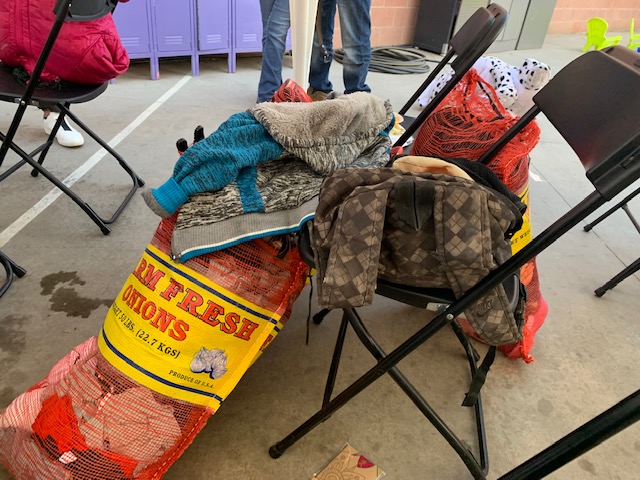
There are those joyous moments, too. Most travel with cell phones and you’ll see them literally jump for joy when they connect with a loved one in the States. Yesterday, one of the men ran around the room with photos of his grandkids. Another ran up to me with a photo of the X-ray of his son in utero, 7 months and counting. One man asked me if there was Mass today – I escorted him to the chapel for some quiet moments alone. I love taking the kids to the children’s area, filled with rocking horses and books and stuffed animals. Beautiful moments.
The staff of Casa Alitas do not know from one day to the next how many people, or if any people, will be arriving at our doorsteps. As you’ve probably heard on the news, the word as of two weeks ago was that the entire border was going to be closed to asylum seekers as of November 1. Well, it’s November 4! My impression is that this policy was deterred, as least for the moment, partially because of the response of activists throughout the United States, including ours in Wisconsin. Everything appears to be in a state of flux, even our immigration policy. You may have heard about the recent meeting in Washington in which activists walked out of a meeting with Biden. Heavy duty!
But I don’t want to leave the impression that it’s been “all work, no play.” I carve out time for many a good restaurant and time with friends. It was a particular joy to have dinner with Delle McCormick, a UCC minister I met in 2019. She has been a primary mover within church circles here at the border, having spent many years working in Mexico and other parts of Latin America. It was fun to find out we were both working in Cuernavaca, Mexico at the same time, only blocks from one another. Delle organized a center specifically for lesbians in Cuernavaca, way before her time. She works with Randy Mayer, another UCC minister at the border.
And some of you will remember the name of Peggy Gessner. Peggy received the boxes of clothing from our clothing drive and made that wonderful video with Steve Sheets. We had lunch recently and I sent a photo of us to Steve. She’s as much a delight in person as she was on the video.
This weekend I hope to visit the church of San Xavier, one of the first churches and schools established by the Dominicans in the Southwest. The church is on the Tohono O’ Odham Indian reservation. You may have heard about their indigenous land that was destroyed to make way for Trump’s border wall. And I want to head up for a walk through Sabino Canyon in the foothills, not far from here. Next week I hope to join a friend for Samaritan trip to the border, when we will do water drops in the desert. I also plan to meet with the director of Borderlinks to explore the possibility of an ORUCC delegation at some point within the next year. More to come……
Blessings,
Ruthanne




